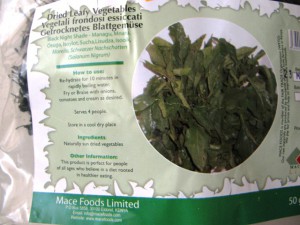- Irish Times does seed saving, well.
- Australia too considers genebanks. In depth.
- “[T]he largest private collection of wild trees in Britain.” All grown from seed.
- James and the Giant Corn gives you the straight dope on the wheat genome … so we don’t have to. Thanks.
- Swiddeners can help with reforestation?
- KIT tells us all about how to make spices sustainable.
Nibbles: Wild tomatoes, Brachiaria, Agroforestry, Syrian drought, Vegetable seeds, Durian
- How cool is it that a descendant of Charles Darwin is working on wild tomatoes on the Galapagos?
- More on the Brazilian “Economic Miracle.”
- Let my people plant trees on farmland!
- Trouble for Syrian agriculture.
- “The D. Landreth Seed Company has sold seeds to every president from George Washington to FDR.” And Obama?
- Views on the durian.
Nibbles: Biotech to the rescue, Chinese horses, Soybean carotenoids, CropMobs, Nutrition, Coffee pests, Varroa, Berries, NUS
- Genejockeys say they have sorted that global food supply problem everybody’s been so antsy about lately. No, wait, maybe it’s this.
- China has 23 indigenous horse breeds. At least.
- Latest crop to get the orange treatment is soybean.
- Diverse ways of doing agriculture: Could CropMobs go global?
- Choose foods, not nutrients. Heck, yes.
- Globally warmed beetles threatening your coffee crops? Bring on biodiversity!
- Brit breeds bees for better grooming.
- How to get the most out of your wild blueberries. Maybe we should tell Medvedev?
- Emerging Crops is a new NUS project, and it has a website.
Nibbles: CIFOR, Weeds, Camelids, Drought, Biofortification, Buckwheat
- CIFOR has a blog!
- Nice series of videos on eating weeds.
- Video on Peru’s “Andean rodeo.” You heard me.
- Africa needs drought-tolerant maize. Ok, fair enough, but here’s my question. Shouldn’t they have done this study before doing all that breeding? Oh, who knows, maybe they did.
- “Biofortification will thus remain relevant to poor rural populations in the years to come, as their incomes will still be far too low to afford a more diversified diet.” What? Who says a diversified diet need be expensive?
- Russia faces looming buckwheat crisis. At least the genetic resources are safe in the Vavilov Institute. Unless of course somebody decides to, I don’t know, build luxury villas there, or something.
Local leafy greens go viral in Kenya
 I continue to be amazed by the progress being made by — or, better, the resurgence of — indigenous leafy greens in Kenya. You can now buy managu (Solanum scabrum?) nicely packaged in supermarkets. Although it is also sold loose on the street.
I continue to be amazed by the progress being made by — or, better, the resurgence of — indigenous leafy greens in Kenya. You can now buy managu (Solanum scabrum?) nicely packaged in supermarkets. Although it is also sold loose on the street.

And this is what the plant looks like.

 I found it in my sister-in-law’s homegarden in Limuru, along with Amaranthus. She didn’t grow either of them until a couple of years back. Progress. More holiday snaps here.
I found it in my sister-in-law’s homegarden in Limuru, along with Amaranthus. She didn’t grow either of them until a couple of years back. Progress. More holiday snaps here.